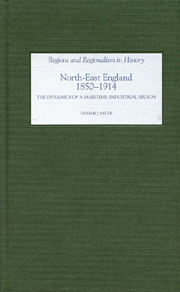Book contents
- Frontmatter
- Contents
- Dedication
- List of illustrations
- Preface
- 1 The North East in time and space
- 2 Horizons: ports, trade and mobility
- 3 Hinterlands and industrial districts
- 4 Making and managing the maritime landscape
- 5 Cohesion and diversity in the maritime urban system
- 6 The horizons of North East shipowning
- 7 Business and the maritime-industrial complex
- 8 Conclusion
- Sources and bibliography
- Index
7 - Business and the maritime-industrial complex
Published online by Cambridge University Press: 12 September 2012
- Frontmatter
- Contents
- Dedication
- List of illustrations
- Preface
- 1 The North East in time and space
- 2 Horizons: ports, trade and mobility
- 3 Hinterlands and industrial districts
- 4 Making and managing the maritime landscape
- 5 Cohesion and diversity in the maritime urban system
- 6 The horizons of North East shipowning
- 7 Business and the maritime-industrial complex
- 8 Conclusion
- Sources and bibliography
- Index
Summary
The investing horizons of shipping firms are an important indicator of the boundaries of North East business in the later nineteenth century, but shipping was just one part of a much larger industrial complex. As was noted in Chapter 3, the Victorians were fond of proclaiming the interconnection of the North East's industries, with coal and iron mining being vital for iron and steel making, which was vital for shipbuilding, which supplied a flourishing shipowning sector, and so on. An integrated industrial system, however, is not necessarily the same thing as an integrated business system, because individual firms and companies may compete and/or collaborate in many different ways. The North East had a fragmented business landscape, with a few large firms and a multitude of smaller operators in most trades, but hypothetically it might have had only one huge steel firm and one huge shipbuilding firm, or one single conglomerate that made all the steel and all the ships – in each of these scenarios, the broad statistical picture would show that steel making was closely connected to shipbuilding. It is obvious, though, that the careers and horizons of North East entrepreneurs, managers and workers would have been fundamentally different in each case, and this business profile has a number of implications for the working of the industrial district, and, crucially, for its internal and external connections.
The maritime industries were at the heart of many of these questions.
- Type
- Chapter
- Information
- North East England, 1850–1914The Dynamics of a Maritime-Industrial Region, pp. 169 - 202Publisher: Boydell & BrewerPrint publication year: 2006



